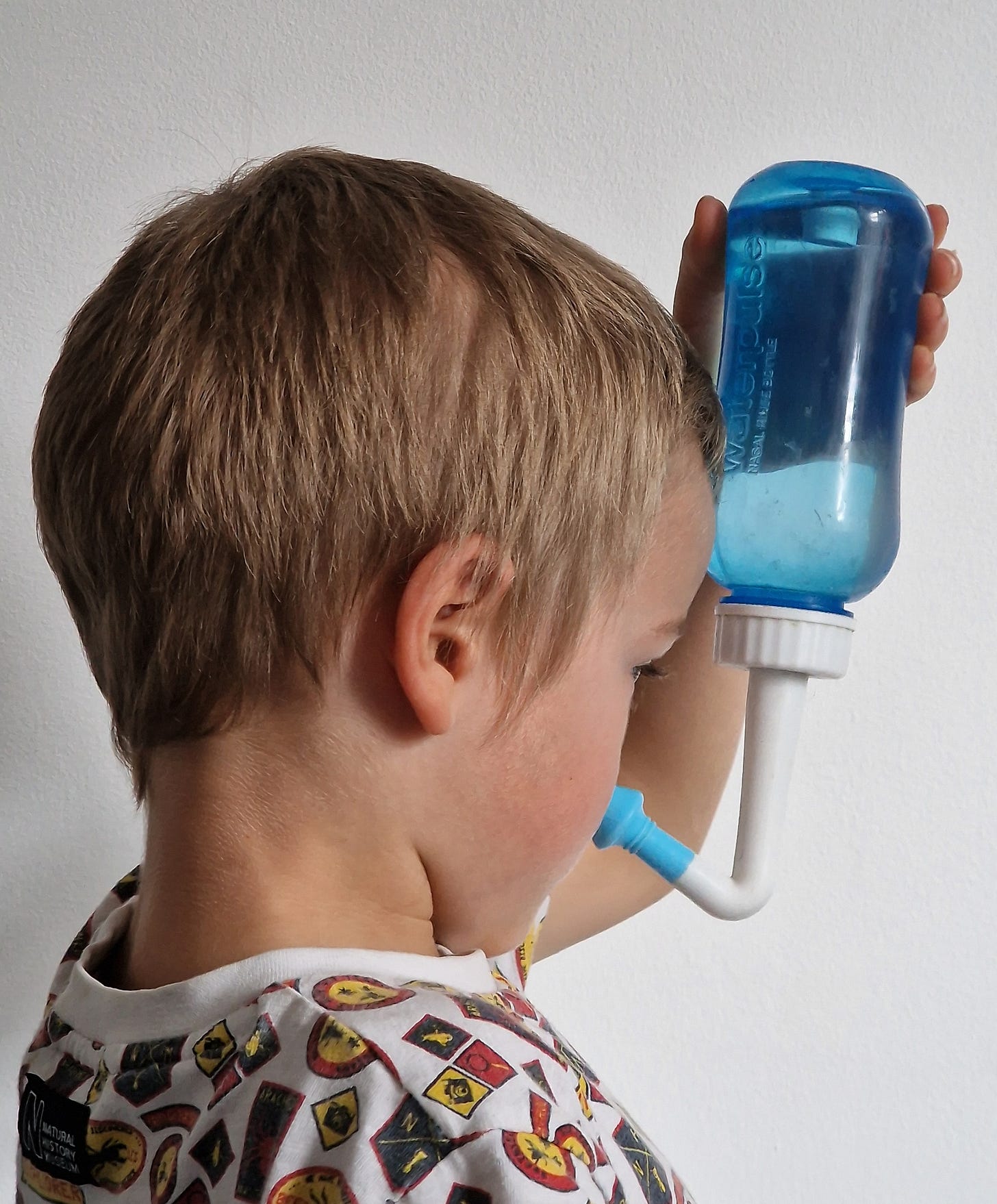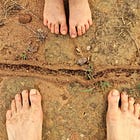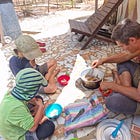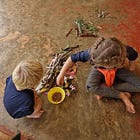What makes children start mouth breathing?
Upper respiratory tract infections help us forget how to breathe
The weight of the cloud pulled it down until its underside drifted between the treetops. A little mist hung in the air, and the water on everything seemed to muffle all sounds. Even the occasional motorbikes, normally so sharp as they passed, were muted as they crawled along trying not to slip on the wet red mud.
As we got closer to the primary school however, the chatter of children and screams of laughter penetrated the humidity just fine. The sounds mingled together with the blue smoke from the fires the kids had lit this morning to burn yesterday's litter. My children saw their friends and ran to join the seething mass of students.
They brought back all sorts of things from school in Tanzania. A working knowledge of Kiswahili for starters. Lizards in their schoolbags. A slightly threatening promise that their headteacher was fetching a snake from the market for them.
But there was one thing they never brought back. A cold.
After gruelling winters in the UK, in which the children became pale and eye-bagged versions of themselves, noses constantly streaming, with coughs that lasted for weeks, winter term in Tanzania was a revelation. The children thrived. The warm temperatures and high humidity meant that the mucosal immune system in their lungs was at the top of its game. And it also meant that the school needed neither windows nor doors. Better ventilation led to less viral transfer, so even if the kids did catch something, the resulting illness was not severe.

Obviously, better respiratory health is better for learning and just better in general, but it also has one specific benefit which is often overlooked: It enabled nearly all of the children we met to hold their mouths closed nearly all of the time.
If you’ve been keeping an eye on the pop-sci best-seller lists (or reading medical journals like, you know, a nerd), you’ll have seen that mouth breathing is an area of health that has recently received a lot of attention. Books like James Nestor's ‘Breathe’ and Patrick McKeown's ‘The Oxygen Advantage’ have raised public awareness of the health costs of improper breathing. We’re now finding out that mouth breathing in childhood affects (amongst other things):
how the jaw grows and therefore how the adult teeth fit into it,
how the air is filtered and therefore lung health and eventual efficiency,
and even how the airway grows and therefore how you sleep later in life.
I cover all of these in my upcoming book, Growing up WEIRD, but today, let's go through the example of school colds. Mouth breathing makes a child not only more likely to catch a cold because the air bypasses the filtering mechanisms in the nose, but also more likely to pass on a cold to others (same mechanism: noses filter air on its way in and on its way out).
But it works the other way too. Blocked noses are the gateway to mouth breathing. There are many factors that make children more likely to hang their mouths open - weak jaw muscles from not chewing enough, habits around finger sucking or pacifier use, and altered neck and shoulder posture because of lack of strength in the upper body. Unfortunately, hanging the mouth open results in forces on the jaw and face that make the face grow differently - it makes the face grow down rather than forward, resulting in a long face and a small jaw.
Mouth breathing is bad for your health, and that’s why it feels unpleasant. Your mouth gets dry, your lips feel cold, and each breath feels shorter and less satisfying. It's not something that anyone chooses because it feels good. It happens when you have no choice. When you feel like you can't breathe through your nose.
For some children, this happens because of allergic rhinitis - that sniffly, eye-watering, throat-itching sickness that comes with the spring, or worse, that settles in to stay year round. For others, this mouth breathing shift comes with a blocked-nose cold. The more reasons a child has to breathe through their mouth (weak jaw muscles, allergies, etc.), the easier they find doing it when they get a cold, and the weaker their drive to get back to normal nose breathing when they recover. Every time that the child's nose is blocked is another opportunity for the self-correction mechanisms to fail, and for the normal air route to change.
The self correction mechanisms depend heavily on that unpleasantness of mouth breathing, because there are several positive feedback loops (that are part of airflow optimisation in normal breathing) that make nose breathing hard to restart if you stop. Here are three of the most powerful:
Nose swelling: Our lungs need enough resistance to exhalation to keep the alveoli open long enough for efficient gas exchange. The body achieves this resistance by having erectile tissue in the nose that swells when exhalation is too rapid, slowing down exhalation and increasing the residence time of the air in the lungs. Of course, if you break the system by exhaling through your mouth (which is very quick and easy), then the swelling of these nasal tissues doesn’t do anything other than make it harder to stop mouth breathing.
Mucus production: Our lungs need wet incoming air to avoid drying out and damaging their delicate tissues. The body gives them this by lining the nose with water-absorbing mucus, which dumps water into the air as it moves past into the lungs. However, if you’re breathing through your mouth, the mucus doesn’t get a chance to dump the moisture. So, it just becomes wetter, bigger, dribblier, and a worse impediment to nose breathing. It also makes the nose surfaces inflamed and the membranes more swollen.
Bony change: Finally, if they don’t get used for a long time, the holes through which the air enters the skull (the ‘internal nares’ or ‘spooky twin-nose-holes you carve into a pumpkin every October’) slowly narrow to provide added skull strength. Very clever. Very irritating.
So it’s not just that children aren’t motivated to breathe through their noses. Allergies and other things make it difficult, and then colds are the perfect breaking point for the nose-breathing habit. . And that’s why, as any parent with a mouth breathing child can tell you, it's really hard to help them back. Not impossible, but really really hard. Easier is to help them not start in the first place. So what can we do?
Avoid open-mouth posture
Treat allergies promptly and consistently
Reduce the number and severity of colds
Helping a child hold their mouth closed starts at birth. Breastfeeding strengthens the facial muscles, making it easier for the child's face to rest in the right position. When the child starts to eat solid foods, the muscular activity of biting and chewing tough or awkward foods with closed lips continues that facial training. For many children, flies, dust storms, and ultra-dry air are frequent reminders to close the lips. For those of us that are cruelly denied these motivators, there are often cultural norms around eating and mouth positions that reinforce good oral posture.
I'll write more on allergic sensitisation in another post, but for today, it's enough just to focus on managing them in the unlucky sufferers. We need to keep the nose open. That means regular, consistent antihistamine treatment, washing the nose out (nasal lavage or irrigation, like this: https://www.healthline.com/health/sinus-flush ) to remove allergens, and doing whatever else we can to reduce allergen load. Current theory of allergy suggests that rapid, effective treatment of allergic symptoms reduces the risk that allergies will become more severe. Immunotherapy may soon also be more widely available.
And finally, we come back to colds. We’ve created the epidemic of children with upper respiratory tract infection because we make them spend the vast majority of their time in poorly ventilated boxes with lots of other people. But we can reduce the likelihood of contracting colds and being sick with them. Hygiene is key. Teaching children to wash their hands, cover their mouth and nose when they cough or sneeze, and blow their nose into a tissue or handkerchief protects themselves and others.

But there’s more we can do to help reduce the risk that a specific cold will cause a permanent shift from nose to mouth breathing.
Dilute mucus and allergens: With young babies, you can use saline drops in the nose to help clear away mucus. Children over about three years can learn how to use a nasal rinse bottle if they have a sticky cold. Although initially spluttery and uncomfortable (have you ever watched a child try to drown itself in a small glass of water?), we've found that children rapidly get it sufficiently right to experience the benefit and will soon ask for the rinse when it's needed. Doing this before bed means that they are much more likely to be able to nose breathe throughout the night.
Evacuate mucus effectively: From the age of 12 months, help them to learn and practise blowing their nose one side at a time into a tissue or handkerchief (with the other nostril blocked with a finger to increase the pressure).
Reduce vascular nasal congestion: From the age of 2 or so, teach children the Buteyko method for clearing a blocked nose (hold the nose closed and nod up and down until you really want to breathe, and then breathe slowly through the nose), is another winner.
Change the nasal environment: Using a gel-based or saline-based nasal spray at the first signs of illness makes a cold last less long (a recent study is cited below) - and kids love sticking stuff up their noses. They can be irritant - it’s easier to teach if adults make it a game and model the correct behaviour.
I've heard it said that mouth breathing is the difference between looking like Napoleon Solo and Napoleon Dynamite. Personally, I think the aesthetic changes are a red herring. I don't really care what you look like. I want you to be able to breathe, eat, talk, etc. Upper Respiratory Tract Infections (i.e. colds) are the perfect storm of drivers to make us forget 200 million years of nose-breathing, and never remember again. Some of the notes here might help avoid that.
You may also like:
Prefer a podcast?
Notes
Pacifier use and malocclusion: https://www.mdpi.com/2039-7283/14/3/57#B17-clinpract-14-00057
Study on nasal sprays and colds: “Compared with participants in the usual care group, who had a mean of 8·2 days of illness, the number of days of illness was significantly lower in the gel-based spray group (mean 6·5 days) and the saline spray group (6·4 days), but not in the group allocated to the behavioural website (7·4 days).” https://www.thelancet.com/journals/lanres/article/PIIS2213-2600(24)00140-1/fulltext
Earlier allergy treatment reduces allergy worsening: Mason, Elizabeth, and Efren Rael. "Sublingual Immunotherapy for Allergic Rhinitis and Asthma." (2018).
Buteyko method for unblocking the nose: https://www.buteykobreathing.nz/page/clear-a-blocked-nose.html










What do you recommend for stopping my three-year-old from mouth-breathing? I suspect she would be resistant to the mouth tape.